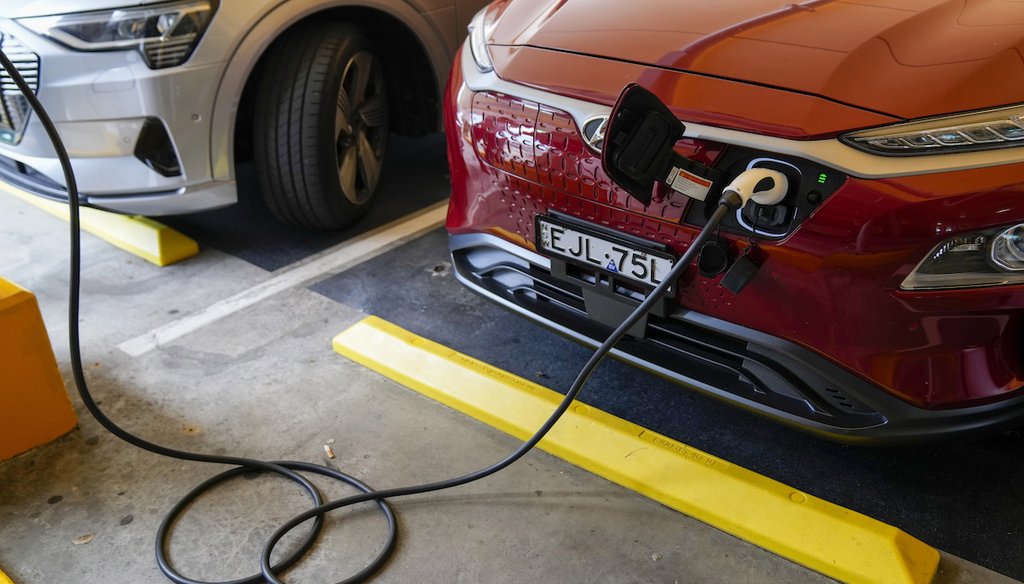

Our only agenda is to publish the truth so you can be an informed participant in democracy.
We need your help.


An electric car gets charged at a supermarket parking lot in Sydney, Australia. (AP)
• Electric vehicles use little power when at a standstill, and their climate settings also do not require much power.
• An electric vehicle with a full battery likely could continue to operate for an entire day or longer while stationary during a traffic jam, without needing to be charged, even while using air conditioning or heating.
A viral Facebook post suggests that electric vehicle advocates have overlooked a fundamental flaw that would make the cars prone to failure and dangerous to their owners in the event of a massive traffic jam.
The post shows a photo of a road packed with vehicles at a standstill and says, "Imagine all of these vehicles being electric powered. It’s 93 degrees outside. A major accident has rendered going anywhere impossible for hours. People are running their AC until all batteries go dead. You can’t jumpstart these cars and trucks like a gas or diesel powered vehicle. They have to be plugged in until recharged. The brains behind the EV movement don't have this figured out. These folks will die from heat, while in cold weather states, people will freeze to death. What do you say to that, Greta Thunberg?"
The post was flagged as part of Facebook’s efforts to combat false news and misinformation on its News Feed. (Read more about our partnership with Facebook.)
The post implies that electric vehicles are more susceptible to this type of failure than internal combustion cars. But that misunderstands how EVs and their batteries work.
Many variables would affect how an EV performs in the situations described in the post compared with an internal-combustion vehicle, including how much fuel or battery power the vehicles started out with, the size of the engine, the capacity of the fuel tank or battery, and the weather — car batteries don’t do as well in the cold.
But there’s one key difference between the two propulsion systems: While an internal-combustion car’s engine stays on and burns fuel while idling, electric vehicles use little battery power when at a standstill.
"The motor doesn’t consume power at zero speed," David Howey, associate professor in engineering science at the University of Oxford’s Department of Engineering Science, told Reuters. "Only the car electronics and heating/cooling systems use power when the car is stationary, and the amounts are relatively small."
Peter Wells, director of the Centre for Automotive Industry Research at Cardiff Business School in Wales, puts it like this: The average U.S. house uses 30 kilowatt-hours of power per day, so a fully charged 62 kilowatt-hour battery in an electric car could power a house for two days.
Even half-charged, a 62 kWh battery could yield 10 to 15 hours of heating in a car that’s stationary during a traffic jam, Wells said. A gasoline car’s heating or air conditioning, on the other hand, wouldn’t be able to operate without the engine running and consuming fuel to power the compressor and other parts.
A British consumer watchdog group tested an electric vehicle’s battery performance during a simulated traffic jam. Using a Volkswagen ID.4 sport utility vehicle, the testers streamed music, turned on the car’s heated seats to maximum settings, turned on the air conditioner, turned on the headlights and used the car’s USB socket to charge a tablet that was playing a movie.
After 75 minutes of using all of those functions while the car was stationary, the car’s main 77 kWh battery lost 2% of its power, equal to 8 miles of driving range.
"In short, a very small amount of the electric car’s battery was used to keep the car comfortable," the testers concluded.
By comparison, idling the engine in a large car or light truck while in a traffic jam might use half a gallon of gas per hour, Wells said, and much more if it is stop-and-go traffic.
A Facebook post says electric vehicles are more prone to a failure in standstill traffic where heating or air conditioning is required.
The post misunderstands the way EVs and their batteries work. Electric vehicles use little power when at a standstill, and their climate settings also do not require much power.
An electric vehicle with a full battery would have enough energy to operate for a day or longer while stationary during a traffic jam, even while using air conditioning or heating.
We rate the claim that electric vehicles are more likely to fail in traffic jams False.
Email interview, Peter Wells, director of the Centre for Automotive Industry Research at Cardiff Business School, Dec. 9, 2021
Facebook post, Nov. 27, 2021
Reuters, "Fact Check-Electric cars not more likely to get stuck in traffic jams," Nov. 5, 2021
Which? News, "Electric cars in traffic jams – will your battery cope?" Aug. 11, 2021
In a world of wild talk and fake news, help us stand up for the facts.
